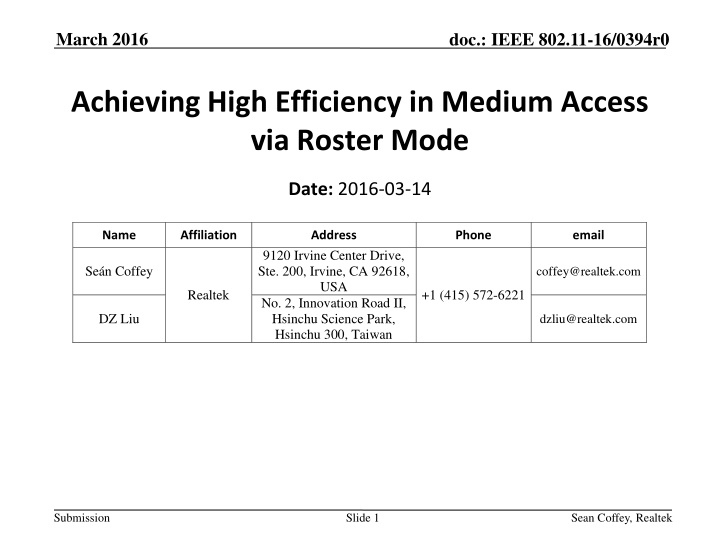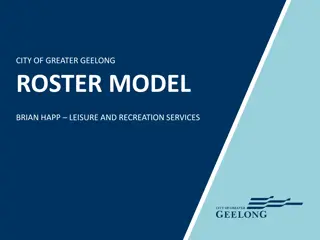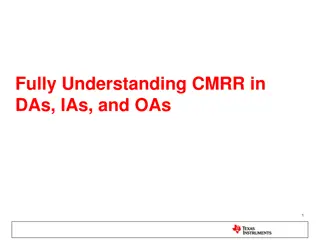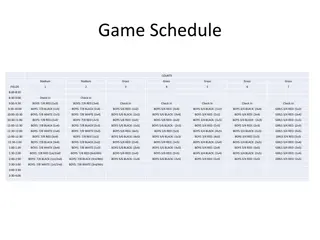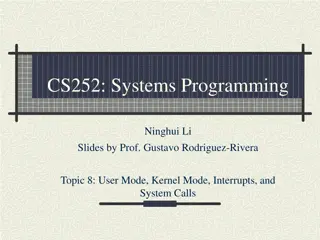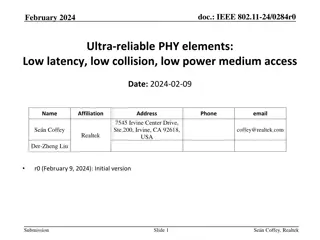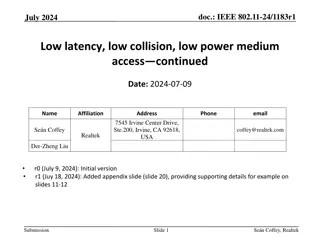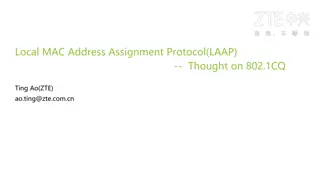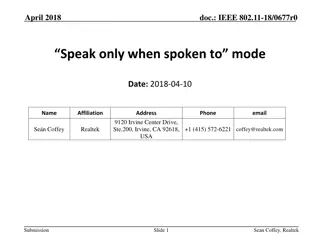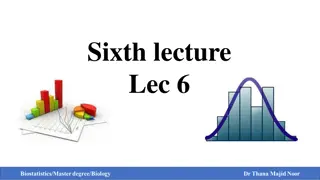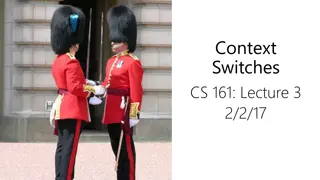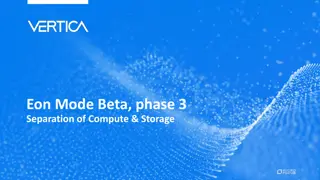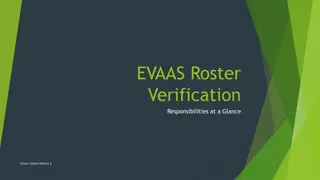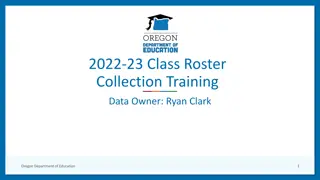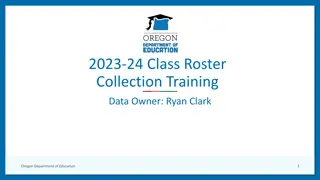Achieving High Efficiency in Medium Access via Roster Mode
Rosters greatly reduce medium access overhead in IEEE 802.11 by providing predictable backoff slots. This presentation extends previous work to show the natural integration with ordinary EDCA, throughput gains, and system state perceptions in medium access. The content covers intuitive developments and examples of synchronized STAs in an EDCA environment.
Download Presentation

Please find below an Image/Link to download the presentation.
The content on the website is provided AS IS for your information and personal use only. It may not be sold, licensed, or shared on other websites without obtaining consent from the author.If you encounter any issues during the download, it is possible that the publisher has removed the file from their server.
You are allowed to download the files provided on this website for personal or commercial use, subject to the condition that they are used lawfully. All files are the property of their respective owners.
The content on the website is provided AS IS for your information and personal use only. It may not be sold, licensed, or shared on other websites without obtaining consent from the author.
E N D
Presentation Transcript
March 2016 doc.: IEEE 802.11-16/0394r0 Achieving High Efficiency in Medium Access via Roster Mode Date: 2016-03-14 Name Affiliation Address Phone email 9120 Irvine Center Drive, Ste. 200, Irvine, CA 92618, USA No. 2, Innovation Road II, Hsinchu Science Park, Hsinchu 300, Taiwan Se n Coffey coffey@realtek.com Realtek +1 (415) 572-6221 DZ Liu dzliu@realtek.com Submission Slide 1 Sean Coffey, Realtek
March 2016 doc.: IEEE 802.11-16/0394r0 Abstract Rosters (i.e., ordered lists) greatly reduce EDCA medium access overhead, by providing 11ax devices with predictable and unique backoff slots, and without requiring scheduling or duration information [1-3]. This presentation extends the previous ones, via: A an intuitive development showing how this mode naturally fits with ordinary EDCA; B results showing throughput gains (where the challenge is to make these gains be low); and C a motion Submission Slide 2 Sean Coffey, Realtek
March 2016 doc.: IEEE 802.11-16/0394r0 Abstract Rosters (i.e., ordered lists) greatly reduce EDCA medium access overhead, by providing 11ax devices with predictable and unique backoff slots, and without requiring scheduling or duration information [1-3]. This presentation extends the previous ones, via: A an intuitive development showing how this mode naturally fits with ordinary EDCA; B results showing throughput gains (where the challenge is to make these gains be low); and C a motion Submission Slide 3 Sean Coffey, Realtek
March 2016 doc.: IEEE 802.11-16/0394r0 Intuitive development (A-1) Time and system state in EDCA as perceived by an example STA: Medium busy AIFS Medium usage (RTS or A-MPDU, maybe collision) Backoff slots Submission Slide 4 Sean Coffey, Realtek
March 2016 doc.: IEEE 802.11-16/0394r0 Development II (A-2) Time and system state in EDCA as perceived by an example STA: s 43 9 9 9 43 9 9 Medium busy AIFS Medium usage (RTS or A-MPDU, maybe collision) Backoff slots Submission Slide 5 Sean Coffey, Realtek
March 2016 doc.: IEEE 802.11-16/0394r0 Development III (A-3) Time and system state in EDCA as perceived by two example STAs: s 43 9 9 9 43 9 9 Medium busy s 34 9 9 9 34 9 9 Medium busy * * Submission Slide 6 Sean Coffey, Realtek
March 2016 doc.: IEEE 802.11-16/0394r0 Development IV (A-4) In EDCA, if two or more STAs (1) each hear same transmissions; (2) have same AC; and (3) experience no collisions Medium busy Medium busy then they remain (unknowingly) synchronized as long as (1)-(3) last Submission Slide 7 Sean Coffey, Realtek
March 2016 doc.: IEEE 802.11-16/0394r0 Development V (A-5) With enough contention, transmitters should usually use RTS-CTS [1]; then, in EDCA, all these devices see the medium usage like this: s 43 9 9 9 52 16 44 16 Medium busy Medium busy i.e., 200 s of medium usage or more before every data start Submission Slide 8 Sean Coffey, Realtek
March 2016 doc.: IEEE 802.11-16/0394r0 Development VI (A-6) If each device knows which backoff slot it may use, and that slot is assigned only to it, we can eliminate almost all of the 200 s s 9 9 9 Initiation A-MPDU A-MPDU A-MPDU 4 ms Initiation informs devices which backoff slots they are assigned within this short time period (looks like a single TXOP to other devices) Submission Slide 9 Sean Coffey, Realtek
March 2016 doc.: IEEE 802.11-16/0394r0 Development VII (A-7) Roster mode creates the required conditions, so that we can eliminate almost all of the 200 s Initiation 4 ms AP restricts to a subset of STAs and reverts to ordinary EDCA at the end informs these STAs which backoff slots they may use Internal roster state vanishes Submission Slide 10 Sean Coffey, Realtek
March 2016 doc.: IEEE 802.11-16/0394r0 Implications (A-8) Processing at each STA follows same form as in ordinary EDCA: only some IFS times change ( feasible to implement) Initiation A-MPDU A-MPDU A-MPDU 4 ms EIFS Relation to ordinary EDCA gives roadmap for full protocol, including exceptions (e.g., defer to end of roster + EIFS, etc.) Submission Slide 11 Sean Coffey, Realtek
March 2016 doc.: IEEE 802.11-16/0394r0 Summary A (A-9) A Intuitive development, relation to ordinary EDCA: Ordinary EDCA already possesses a significant degree of automatic synchronization, simply from devices each following the same protocol Roster mode systematizes this synchronization for very short time period Processing at individual STA follows all the rules of ordinary EDCA: only some aspects of timing change Recovery rules also inherit the structure of ordinary EDCA Submission Slide 12 Sean Coffey, Realtek
March 2016 doc.: IEEE 802.11-16/0394r0 Abstract Rosters (i.e., ordered lists) greatly reduce EDCA medium access overhead, by providing 11ax devices with predictable and unique backoff slots, and without requiring scheduling or duration information [1-3]. This presentation extends the previous ones, via: A an intuitive development showing how this mode naturally fits with ordinary EDCA; B results showing throughput gains (where the challenge is to make these gains be low); and C a motion Submission Slide 13 Sean Coffey, Realtek
March 2016 doc.: IEEE 802.11-16/0394r0 Frames (B-1) Frame formats to enable roster mode: see Appendix A Initiation CTS to Self RI CTS CF-End s 44 60 16 60 16 44 16 If necessary Variable Submission Slide 14 Sean Coffey, Realtek
March 2016 doc.: IEEE 802.11-16/0394r0 Scenarios (B-2) 1 ms N = 3 4 ms N = 20 WORSE BETTER Internal hidden nodes No hidden nodes Let s look at the less promising cases It s natural to discount high gain numbers if there are any assumptions that are at all optimistic It s useful to see how well a mode does in less-than-ideal conditions Submission Slide 15 Sean Coffey, Realtek
March 2016 doc.: IEEE 802.11-16/0394r0 Scenario 1 (B-3) Roster duration 1 ms, with data packets 150-250 s where present 1/2 of participating devices have data; no internal hidden nodes 196 9 150 9 250 27 200 18 60 65% CF-End Initiation Data IFS + Backoff Appendix B EDCA, with 20 competing devices, has 56% efficiency Roster mode throughput change: +17% Submission Slide 16 Sean Coffey, Realtek
March 2016 doc.: IEEE 802.11-16/0394r0 Scenario 2 (B-4) Roster duration 3.25 ms, with data packets 150-250 s where present 1/2 of participating devices have data; 1/4 have internal hidden nodes 196 9 200 18 120 200 18 60 74% CF-End CTSs Initiation Data Appendix B EDCA, with 20 competing devices, has 56% efficiency Roster mode throughput change: +33% Submission Slide 17 Sean Coffey, Realtek
March 2016 doc.: IEEE 802.11-16/0394r0 Scenario 3 (B-4) Roster duration 4 ms, with data packets 150-250 s where present 1/3 of participating devices have data; no hidden nodes (BSS or OBSS) 136 18 200 27 200 27 60 83% CF-End Initiation Data Appendix B EDCA, with 20 competing devices, has 56% efficiency Roster mode throughput change: +48% Submission Slide 18 Sean Coffey, Realtek
March 2016 doc.: IEEE 802.11-16/0394r0 Scenario 4 (B-4) Roster duration 3.2 ms, with data packets 50-100 s where present 1/2 of participating devices have data; no hidden nodes (BSS or OBSS) 136 9 75 18 75 18 60 75% CF-End Initiation Data Appendix B EDCA, with 50 competing devices, packets 75 s, has 36% efficiency Roster mode throughput change: +108% Submission Slide 19 Sean Coffey, Realtek
March 2016 doc.: IEEE 802.11-16/0394r0 Summary B (B-5) B Roster mode provides consistent gains across scenarios Even where roster mode has relatively unfavorable conditions while ordinary EDCA does well It s not straightforward to find natural conditions where it does not provide a gain Relative gains of roster mode increase with decreasing packet size and increasing number of competing devices I.e., in conditions where channel access overhead is a more significant factor, and in which contention overhead is greater Submission Slide 20 Sean Coffey, Realtek
March 2016 doc.: IEEE 802.11-16/0394r0 Abstract Rosters (i.e., ordered lists) greatly reduce EDCA medium access overhead, by providing 11ax devices with predictable and unique backoff slots, and without requiring scheduling or duration information [1-3]. This presentation extends the previous ones, via: A an intuitive development showing how this mode naturally fits with ordinary EDCA; B results showing throughput gains (where the challenge is to make these gains be low); and C a motion Submission Slide 21 Sean Coffey, Realtek
March 2016 doc.: IEEE 802.11-16/0394r0 Straw poll 1 (pre-motion) (C-1) Do you support adding to the SFD: The 11ax specification shall include at least one mode of operation in which: an AP may specify the order (within some specified time period) in which (a specified set of) STAs are permitted to transmit, no two STAs are permitted to transmit simultaneously, the durations of the STA transmissions are not signalled in advance of their commencement, and a STA s starting transmission time is determined by the actual (rather than scheduled) end of the previous STA s transmission Submission Slide 22 Sean Coffey, Realtek
March 2016 doc.: IEEE 802.11-16/0394r0 Motion 1 (C-1) Do you support adding to the SFD: The 11ax specification shall include at least one mode of operation in which: an AP may specify the order (within some specified time period) in which (a specified set of) STAs are permitted to transmit, no two STAs are permitted to transmit simultaneously, the durations of the STA transmissions are not signalled in advance of their commencement, and a STA s starting transmission time is determined by the actual (rather than scheduled) end of the previous STA s transmission Submission Slide 23 Sean Coffey, Realtek
March 2016 doc.: IEEE 802.11-16/0394r0 References [1] IEEE doc. 11/15-1114r1, Airtime Analysis of EDCA , S. Coffey, D.Z. Liu (Realtek), September 2015 [2] IEEE doc. 11/15-1115r1, High Efficiency in Accessing the Medium , S. Coffey, D.Z. Liu (Realtek), September 2015 [3] IEEE doc. 11/16/0102r1, High Efficiency in Accessing the Medium via Rosters, S. Coffey, D.Z. Liu (Realtek), January 2016 Submission Slide 24 Sean Coffey, Realtek
March 2016 doc.: IEEE 802.11-16/0394r0 APPENDIX Submission Slide 25 Sean Coffey, Realtek
March 2016 doc.: IEEE 802.11-16/0394r0 Appendix A Frame formats Example format for Roster Initiation frame: Octets: 2 1 1 0 or 1 0 to (e.g.) 16 Roster ID Offset Control Number Usage Imm Ack Protection Exter Prot Variable Variable Variable Variable Control indicates which variable bitmaps are present Number indicates number of bytes per following field Usage, Immediate Ack, Protection, External Protection are bitmaps Submission Slide 26 Sean Coffey, Realtek
March 2016 doc.: IEEE 802.11-16/0394r0 Appendix B Throughput gains For performance of ordinary EDCA, see [1, slide 19] Roster mode: Scenario 1: total duration = 196 + 3 x (18 + 200) 9 + 18 + 60 = 919 s, of which 600 s carry data: efficiency = 600 / 919 65% Scenario 2: total duration = 196 + 3 x (18 + 120 + 200) + 9 x (18 + 200) 9 + 18 + 60 = 3.241 ms, of which 12 x 200 s carry data: efficiency = 2.4 / 3.241 74% Scenario 3: total duration = 136 + 16 x (27 + 200) 9 + 27 + 60 = 3.846 ms, of which 16 x 200 s carry data: efficiency = 3.2 / 3.846 83% Scenario 4: total duration = 136 + 32 x (18 + 75) 9 + 18 + 60 = 3.181 ms, of which 32 x 75 s carry data: efficiency = 2.4 / 3.181 = 75% Note: both ordinary EDCA and roster mode efficiencies are calculated without Acks or Block Acks Submission Slide 27 Sean Coffey, Realtek
March 2016 doc.: IEEE 802.11-16/0394r0 Appendix C Notes 1. In [3], the interframe spacing within roster mode was reduced to a VIFS (Vestigial Inter-Frame Space), which could be as small as 4 s or so. The current presentation alters this to 9 s, i.e., a single slot time. The gains over ordinary EDCA are large enough anyway. 2. Roster mode requires setup and periodic maintenance, which imposes extra overhead. This is not shown explicitly in slides 16-19, but the examples were chosen to account for this effect. With total setup from scratch 500 s-5 ms, 100 uses of a roster before it is discarded, and 6 successful transmissions per roster use, the amortized cost is < 1 s to < 9 s per successful transmission, i.e., at worst less than one backoff slot time. This is why the probability of slot use in the examples was chosen to be quite low: it s equivalent to a higher probability of slot use with an extra slot to account for setup and maintenance overhead. 3. For protection of legacy modes: this is an issue that affects all new 11ax modes, and roster mode can use whatever general solution is adopted. For a specific solution, see [3, slides 21-23] (roster mode forms single EDCA state, with sufficient silent time afterwards to permit equalizing channel access opportunities). Submission Slide 28 Sean Coffey, Realtek
March 2016 doc.: IEEE 802.11-16/0394r0 Notes II 4. Internal hidden nodes are those that are internal to the roster [3]. It is only necessary to protect those STAs that are hidden to one or more STAs that follow it in the roster, given the offset used. 5. The roster initiation sequence (CTS-To-Self followed by a new RI packet) could be replaced by a single packet, increasing the efficiency. For example, this single packet could be an HE trigger frame. Alternatively, with CTS-To-Self followed by RI, the RI packet may be sent at any rate that can be decoded by the devices in the roster, i.e., not necessarily at the lowest basic rate. 6. Roster mode is primarily directed at uplink traffic, but there is no reason that downlink traffic cannot be included. The AP may reserve any subset of slots for its own use.. Apart from permitting DL traffic with less overhead, this aids roster management (AP reserves some slots and transfers them to selected STAs via direct exchange of messages). Similarly traffic can in principle be MU / OFDMA. Submission Slide 29 Sean Coffey, Realtek
